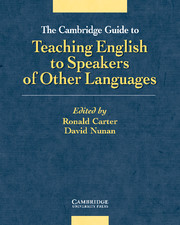Book contents
- Frontmatter
- Contents
- List of figures
- List of abbreviations
- Acknowledgements
- List of contributors
- Introduction
- Chapter 1 Listening
- Chapter 2 Speaking
- Chapter 3 Reading
- Chapter 4 Writing
- Chapter 5 Grammar
- Chapter 6 Vocabulary
- Chapter 7 Discourse
- Chapter 8 Pronunciation
- Chapter 9 Materials development
- Chapter 10 Second language teacher education
- Chapter 11 Psycholinguistics
- Chapter 12 Second language acquisition
- Chapter 13 Bilingualism
- Chapter 14 Sociolinguistics
- Chapter 15 Computer-assisted language learning
- Chapter 16 Observation
- Chapter 17 Classroom interaction
- Chapter 18 English for academic purposes
- Chapter 19 English for specific purposes
- Chapter 20 Assessment
- Chapter 21 Evaluation
- Chapter 22 Syllabus design
- Chapter 23 Language awareness
- Chapter 24 Language learning strategies
- Chapter 25 Task-based language learning
- Chapter 26 Literature in the language classroom
- Chapter 27 Genre
- Chapter 28 Programme management
- Chapter 29 Intercultural communication
- Chapter 30 On-line communication
- Postscript: The ideology of TESOL
- Glossary
- References
- Index
Chapter 9 - Materials development
Published online by Cambridge University Press: 07 September 2010
- Frontmatter
- Contents
- List of figures
- List of abbreviations
- Acknowledgements
- List of contributors
- Introduction
- Chapter 1 Listening
- Chapter 2 Speaking
- Chapter 3 Reading
- Chapter 4 Writing
- Chapter 5 Grammar
- Chapter 6 Vocabulary
- Chapter 7 Discourse
- Chapter 8 Pronunciation
- Chapter 9 Materials development
- Chapter 10 Second language teacher education
- Chapter 11 Psycholinguistics
- Chapter 12 Second language acquisition
- Chapter 13 Bilingualism
- Chapter 14 Sociolinguistics
- Chapter 15 Computer-assisted language learning
- Chapter 16 Observation
- Chapter 17 Classroom interaction
- Chapter 18 English for academic purposes
- Chapter 19 English for specific purposes
- Chapter 20 Assessment
- Chapter 21 Evaluation
- Chapter 22 Syllabus design
- Chapter 23 Language awareness
- Chapter 24 Language learning strategies
- Chapter 25 Task-based language learning
- Chapter 26 Literature in the language classroom
- Chapter 27 Genre
- Chapter 28 Programme management
- Chapter 29 Intercultural communication
- Chapter 30 On-line communication
- Postscript: The ideology of TESOL
- Glossary
- References
- Index
Summary
Introduction
Materials development is both a field of study and a practical undertaking. As a field it studies the principles and procedures of the design, implementation and evaluation of language teaching materials. As an undertaking it involves the production, evaluation and adaptation of language teaching materials, by teachers for their own classrooms and by materials writers for sale or distribution. Ideally these two aspects of materials development are interactive in that the theoretical studies inform and are informed by the development and use of classroom materials (e.g. Tomlinson 1998c).
‘Materials’ include anything which can be used to facilitate the learning of a language. They can be linguistic, visual, auditory or kinesthetic, and they can be presented in print, through live performance or display, or on cassette, CD-ROM, DVD or the internet. They can be instructional in that they inform learners about the language, they can be experiential in that they provide exposure to the language in use, they can be elicitative in that they stimulate language use, or they can be exploratory in that they seek discoveries about language use.
Background
HISTORICAL DEVELOPMENT
Studies of materials development are a recent phenomenon. Until recently materials development was treated as a sub-section of methodology, in which materials were usually introduced as examples of methods in action rather than as a means to explore the principles and procedures of their development. Books for teachers included examples of materials in each section or separately at the end of a book, usually with pertinent comments (e.g. Dubin and Olshtain 1986; Richards and Rodgers 1986; Stevick 1986, 1989; Nunan 1988a; Richards 1990), but materials development was not their main concern.
- Type
- Chapter
- Information
- Publisher: Cambridge University PressPrint publication year: 2001
- 41
- Cited by



